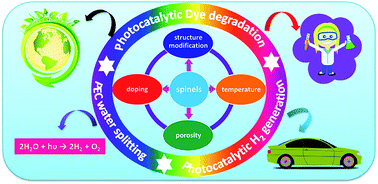Spinel photocatalysts for environmental remediation, hydrogen generation, CO2 reduction and photoelectrochemical water splitting
Abstract
Over the past few decades, owing to their unique functional properties such as physical, chemical, optical and electronic properties, spinel materials have attracted significant scientific attention in heterogeneous photocatalyst research. Here, we review the main fundamental understanding of the correlations between the performance of spinel structures and their particle shape, size, chemical composition, and photo-Fenton reactions for photocatalytic applications; these include photocatalytic dye degradation for environmental remediation, photocatalytic hydrogen generation, CO2 reduction and photoelectrochemical water splitting. In addition, the key factors and essential strategies to improve their performance and functionality are discussed in detail. Future research pathways and perspectives on the progress of these high performance and cost effective renewable energy materials are provided, along with the improvements in material properties that are necessary to replace current commercial energy materials. It is envisioned that further investigations should focus on surface modification, integrating conductive matrixes and regulating the spinel composition, which will make spinels promising photocatalysts.

- This article is part of the themed collections: Recent Review Articles and 2018 Journal of Materials Chemistry A HOT Papers


 Please wait while we load your content...
Please wait while we load your content...